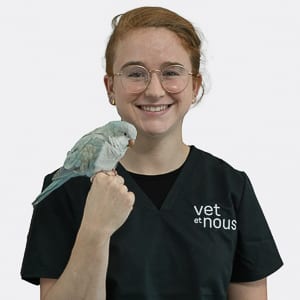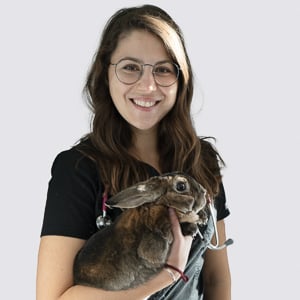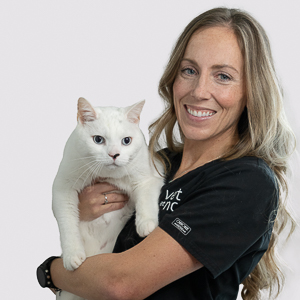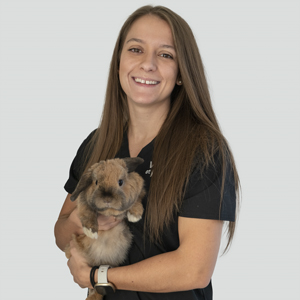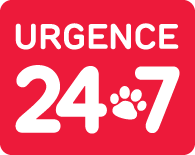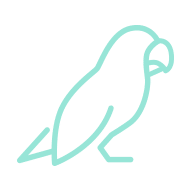
Our team at Centre Vétérinaire Laval is specializing in birds and exotic animals is always ready to welcome you, whether you are referred by your family veterinarian or when your animal has an accident. Thanks to our state-of-the-art equipment, the expertise of our veterinarians and the hard work of our animal health technicians, we remain available to take care of your animal as if it were our own.
My pet is sick…but is it an emergency? Read our useful guide to recognize the signs of illness in your exotic pet and know when to consult in emergency.
Our team accommodates most exotic animals:
- Birds
- Small mammals
- Rabbits
- Ferrets
- Hedgehogs
- Rodents
- Sugar gliders
- Etc.
- Reptiles
Our services
The clinical exam includes several components. The anamnesis, or medical history, provides information about the presenting problem and any previous medical conditions. Since inappropriate husbandry is often at the source of illness in birds and exotic animals, the animal’s husbandry including its environmental, nutritional and social conditions is thoroughly reviewed. The distant examination allows the veterinarian to gather information (the posture, plumage, or stools for example) without having to manipulate the animal, while allowing it to acclimate to the hospital environment. Should an animal be presented in critical condition, the veterinarian may limit the clinical exam to the distant examination to reduce handling until the animal is stabilized. Finally, the physical examination of the animal involves handling or restraint in order to evaluate certain structures using observation, palpation and auscultation. The weight of the animal is recorded, and the body score is determined.
The clinical exam allows the veterinarian to establish a list of problems, and to suggest a list of possible diagnoses. The clinical exam is the backbone of the clinical picture that the veterinarian attempts to draw in order to recommend an appropriate treatment. At the conclusion of a clinical exam, the veterinarian may propose complementary tests to complete the clinical picture. It is important to note that the information provided by complementary testing reflects the condition of the animal at the moment of the test. Some complementary tests may need to be repeated over time to establish the trend of an illness or to carry out a follow-up exam. The complementary tests commonly used in avian and exotic animal medicine are detailed below.
The medical approach is unique when the ‘patient’ consists of a population of individuals. The aviculture examination comprises the basics of an individual clinical exam, and much more. In fact, an aviculture examination requires the clinical exam of at least one individual of a given group, from which it is possible to extrapolate relevant details. Thereafter, emphasis is placed on the evaluation of the breeding facility’s husbandry. In particular, the evaluation takes into account the specific needs of a species, the demands related to reproduction, the control of contagious diseases, and neonatal parameters. A report detailing the findings and recommendations is provided after the examination. Appropriate complementary tests are proposed as needed.
Parrots are highly intelligent and social animals requiring constant intellectual and social stimulation. These needs are difficult to meet within the confines of a normal daily life. Many birds develop so-called ‘undesirable’ behaviours in response to these deficiencies. These behaviours can be detrimental to the relationship between a bird and its owner, and can lead to the neglect and abandonment of the animal. The purpose of a behaviour consultation is to describe the undesirable behaviour within the context of a bird’s social and intellectual requirements, to identify its triggers, and to provide advice on how to prevent and modify it. The behaviour consultation is a first step towards attaining a better understanding of the bird’s needs and an improvement in the relationship between the bird and its owner.
It may be necessary to hospitalize an animal in poor condition. At the Centre Vétérinaire Laval, the Birds and Exotic Animals department is isolated from traditional pets and provides installations that are adapted to the species we treat. Our hospital ward, located in a peaceful environment, was built to accommodate animals of various shapes and sizes. Hospital cages and incubators can be individually controlled to meet the temperature and humidity requirements of our patients. Intensive care is provided to our most critically ill patients. A devoted team is trained to care for our patients and administer daily treatments. Pet owners receive daily updates to stay informed on the evolution of their pet’s condition. If the patient’s stay extends over several days, and if its condition allows, it is possible to organize visits. When a patient is ready to leave the hospital, an appointment with a trained technician is scheduled during which the owner is shown how to administer treatments to their pet. A written report that describes the condition, treatments received during hospitalization and short- or long-term recommendations are provided to the owner.
Diagnostic procedures
Medical imaging includes several modalities of acquisition and reconstruction of images of an animal’s body. Radiology, fluoroscopy, computed tomography (CT scan), magnetic resonance (MRI), ultrasonography and endoscopy provide a visual representation of certain pathological conditions (fractures, displacement of organs, enlargement of organs, etc.). The different facets of medical imaging are complementary and are recommended by the veterinarian based on the suspected illness and the limitations imposed by the animal’s condition.
Stool analysis is a procedure that involves the collection and analysis of fecal matter to determine the presence of a medical condition. Most often, these tests are used to identify targeted micro-organisms. Certain parasites, fungi, bacteria and viruses are detected from stool samples. Stool analysis can also be used to explore non-infectious conditions. Our on-site laboratory provides rapid results for numerous analyses.
Culture is a method of propagation of microbial organisms in special media conducive to their growth under controlled laboratory conditions. Microbial cultures are used to isolate and identify the cause of an infectious disease. Viral, bacterial and fungal cultures can be performed from a swab or from a body fluid sample. Complementary tests can provide information on sensitivity to antimicrobial drugs, which is key to prescribing appropriate medications.
Cytology is the analysis of cells from a body fluid or biological tissue. A small sample is collected (usually using a needle and syringe), smeared on a slide, stained and examined under a microscope. Cytology is primarily used to detect signs of infection or cancer. The procedure is of short duration and may require sedation and analgesia (pain control).
The loss of a pet can cause a strong emotional response, one that may interfere with objective decision-making. Under certain circumstances, a veterinarian may recommend a necropsy to determine the cause of death, or the state of the animal prior to its death. This is particularly important when there is a risk of contagious disease and there has been contact with other animals. However, the interest of a necropsy is not only clinical: the grieving process can be made easier to bear when the cause of death is known. It is possible to return the animal’s body to the owner following a necropsy to allow cremation or burial. This last step is also important for the grieving process, and it is encouraged.
Non-surgical medical procedures
A microchip is a small electronic element the size of a grain of rice. It is injected under the skin or in the muscle of an animal. It is activated by radioelectric waves that are emitted by a microchip scanner. A random number is assigned to each microchip. This number, along with the coordinates of the owner, is registered in a form provided by the manufacturer. The owner receives a copy, the original is sent to the manufacturer where it is recorded in a database. If an animal is found and scanned (usually by a shelter or veterinarian), the owner can be contacted through the manufacturer. It should be noted that microchips are not tracking devices and thus do not allow one to locate an animal by GPS.
Beak trims are recommended for birds (and some reptiles) whose beak growth or wear is abnormal. A bird may be prevented from eating if the conformation of its beak is abnormal. To know if a bird’s beak is normal, it can be compared to a bird of the same species, or be examined by an avian veterinarian. A healthy bird should not require beak trims – that’s why this procedure is considered a medical procedure and not just grooming. If a beak trim is required, it is important to find the underlying cause of the abnormal conformation to treat it if possible. A clinical exam is therefore required for the initial consultation for a beak trim. If beak trims are required, it is usually necessary to have it done regularly for the entirety of the animal’s life.
Acquired dental disease is frequently diagnosed in companion rabbits and rodents. The continual growth of teeth requires that they be worn down evenly in order to maintain a normal length. Any abnormality in shape, position or structure can interfere with normal wear, resulting in elongation of teeth and painful consequences.
Teeth trimming, treatment of associated dental infection, and pain control can temporarily alleviate an animal suffering from acquired dental disease. However, since rabbit teeth grow continuously, it is usually necessary to manage this illness for the life of the animal.
Management of acquired dental disease involves:
- An annual clinical exam
- Radiographic or computed tomography (CT scan) dental exams, in some cases
- Teeth trimming on a monthly basis, at least for the first few months*
- Administration of antibiotics if needed
- Administration of analgesics (pain relievers) if needed
- Gradual correction of diet if appropriate
- A commitment to follow rigorous medical monitoring
*Teeth trimming can be done on an awake animal in some cases; in cases of advanced stages of acquired dental disease, general anesthesia may be required.
Surgery
Castration is recommended to prevent reproduction. It may also be indicated to reduce certain behaviours (aggression and territorialism, for example). It is recommended to have an animal castrated as soon as the testicles appear in the scrotal sac. Please contact us to know your pet’s recommended age for this procedure.
Sterilization (ovariohysterectomy) of the female rabbit is strongly recommended to prevent uterine cancer. This type of cancer is common in rabbits from 2 to 8 years of age. Rabbits should be sterilized ideally between the ages of 6 and 12 months.
A clinical exam is necessary before any surgical procedure in order to ensure that the animal is healthy. The clinical exam must be performed no more than 6 months prior to the surgery. The animal is brought to the hospital the day prior to the surgery. A pre-anesthetic exam is performed immediately before the procedure, as this surgery requires general anesthesia. Medication is administered before the surgery to prevent anxiety and pain and to ease recovery. The animal stays in the hospital until the following day to allow for post-operative monitoring. It is not necessary to return to the hospital to have sutures removed in the case of a castration. However, a follow-up visit for suture removal, included in the cost of surgery, is recommended 2 weeks post-operatively in the case of sterilization of females.
The detection or confirmation of a suspected illness can require surgical sampling of biological tissues. A biopsy is a diagnostic procedure that involves sampling microscopic analysis of body tissue by a veterinary pathologist. It is often associated with other complementary tests in order to complete a clinical picture and confirm a diagnosis. Many analyses can be performed from a biopsy sample, providing information on the presence or nature of a cancer, of an infectious process, and metabolic disease among others. General anesthesia is usually required to obtain a biopsy sample.
Grooming
Feather trimming is performed to reduce flight. Flight reduction is recommended to reduce the risks of escape (especially during the summer months), to allow the bird to go outside without restraint, or to facilitate training. The number of feathers to trim and the length of feather to remove depend on the age of the bird, its physical health, and the expectations of the owner. Feather trimming is ideally performed after a moult, so that the trim will last until the next moult. Inappropriate wing trimming can lead to serious physical and psychological problems; it is therefore recommended to have this procedure performed by an experienced handler. It is important to recognize that even with an appropriate wing trim, a bird can glide several metres (and much more in windy conditions).
We are here for your companions!
Dr. Sarah
Alberton v.m., IPSAV (zoologic medicine) Centre Vétérinaire LavalDr. Raphaëlle
Boudreau v.m., IPSAV (zoologic medicine) Centre Vétérinaire LavalDr. Julie
Hébert v.m., Dipl. ABVP (pratique aviaire), Dipl. ACEPM Centre Vétérinaire LavalDr. Kim
Langlois v.m. Centre Vétérinaire LavalDr. Édouard
Maccolini v.m., Dipl. ABVP (pratique aviaire), Dipl. ACEPM Centre Vétérinaire LavalDr. Marie-Pier
Proulx v.m., Dipl. ABVP (Exotic Pet Mammals) Centre Vétérinaire Laval
Did you know that we also have general veterinarians who can treat certain exotic animals in our general practice facilities?
Visit the following page to learn more.


